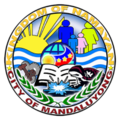Namayan | |
|---|---|
| Motto: "Tara Na Isang Namayan Tayo!" English: "Come On We Are One Namayan!" | |
 | |
| Coordinates: 14°34′51.76″N121°1′11.61″E / 14.5810444°N 121.0198917°E | |
| Country | |
| Region | Metro Manila |
| City | |
| Government | |
| • Type | Sangguniang Barangay |
| • Barangay Captain | Victor Emmanuel Francisco Jr. (PFP) |
| • SK Chairman | Maverick Ross A. Solano (BN) |
| Area | |
• Total | 0.3855 km2 (0.1488 sq mi) |
| Population (2020) | |
• Total | 7,670 |
| • Density | 19,900/km2 (51,500/sq mi) |
| Demonym | Namayaneño |
| Time zone | UTC+8 (Philippine Standard Time) |
Namayan is a barangay in the city of Mandaluyong, Philippines. [1] It is located in the western part of the city near the border with Santa Ana, Manila and Kasilawan and Carmona, Makati, separated from them by the Pasig River. The barangay covers an area of 38.55 hectares (95.3 acres), [2] and is bordered by the barangays of Mabini J.P. Rizal and Old Zañiga on the northside, and Vergara on the eastside. According to the 2020 census, it has a population of 7,670 people. [2]
Contents
Namayan was the center of a pre-Hispanic kingdom that covered much of the modern city of Manila and surrounding cities in southern and eastern Metro Manila. It was also spelled as Lamayan. [3] : 83

